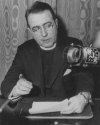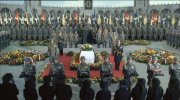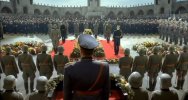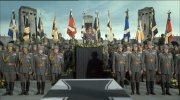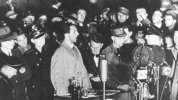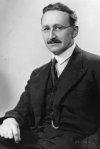You are using an out of date browser. It may not display this or other websites correctly.
You should upgrade or use an alternative browser.
You should upgrade or use an alternative browser.
Photos from Featherston's Confederacy/ TL-191
- Thread starter Alternatehistoryguy47
- Start date
-
- Tags
- the rising sun
Picture of John Schrank, the man who attempted to take Theodore Roosevelt's life during the fall campaign of the 1912 United States election.
Schrank was an immigrant from what is now today Bavaria, Germany. When Roosevelt was giving a campaign speech in Milwaukee, Wisconsin, Shrank shot him. The assassination failed as the 50-page text of his campaign speech folded over twice in Roosevelt's breast pocket, and a metal glasses case slowed the bullet, saving his life. Schrank was immediately disarmed, captured, and might have been lynched had Roosevelt not shouted for Schrank to remain unharmed. Roosevelt continued the speech for another couple of minutes before going to the hospital. A month later, TR was elected President.
Some believed that Schrank was a Confederate spy, as Roosevelt campaigned on a hard stance on the Confederacy. Soon after the assassination attempt, psychologists examined Schrank and reported that he had "insane delusions, grandiose in character," declaring him to be insane. Schrank claimed to have seen the ghost of Thomas Reed in a dream that he is the only one to save America from destruction by killing Roosevelt [1] during his trial. He was sentenced to Central State Hospital for the Criminally Insane in Waupun, Wisconsin, in 1914. He remained there for 29 more years until he died of bronchial pneumonia on September 15, 1943.
References
1. In otl, he claimed to have seen the ghost of William McKinley to avenge his assassination by killing Roosevelt. I chose Reed because we don't know if McKinley was ever President, and there was a line in Blood and Iron that mentioned that no President in the USA or CSA had been assassinated by 1922.
David Saul Goldman (October 3rd, 1899 - August 13th, 1945), more commonly known by his middle name, was a Jewish-Confederate Freedomite Radio Host, who served as the Chief Propagandist for the Freedom Party, and then the Director of Communications from 1934-1944. He was one of Jake Featherston's closest and most devoted acolytes, known for his skills in public speaking and his deeply virulent antiafricanism, which was evident in his publicly voiced views. He advocated progressively harsher discrimination, including the extermination of the Negroes in the Maafa.
Goldman, who was inspired to be a Lawyer since childhood, obtained a Law Degree at the University of Florida, passing the Bar Exam in 1921. Just 4 years prior, Goldman started a Radio Station called "Golden Goodman's Galla", gaining a lot of fans and newspaper coverage. In 1923, he agreed with Gregory Stingry to move operations to Sonora and Chihuahua, eventually meeting Featherston and allowing him and the Freedom Party to use his facilities for speechmaking, thus allowing Featherston's message to reach every corner of the country, especially the Western Confederacy, which proved to be effective in 1933. After the Freedomites came to power in 1934, Goldman's Propaganda Ministry quickly gained and exerted control over the news media, arts, and information in the Freedomite Confederacy. He was particularly adept at using the relatively new media of radio and film for propaganda purposes. Topics for party propaganda included antiafricanism, attacks on the Jewish synagogues by the United States, and (after the start of the Second Great War) attempting to shape morale.
In August 13th, 1945, along with Ferdinand Koenig and Jefferson Pinkard, Saul Goldman was executed by the United States government for crimes against humanity for his part in the Maafa; even though killing no one with his own hands.
Goldman, who was inspired to be a Lawyer since childhood, obtained a Law Degree at the University of Florida, passing the Bar Exam in 1921. Just 4 years prior, Goldman started a Radio Station called "Golden Goodman's Galla", gaining a lot of fans and newspaper coverage. In 1923, he agreed with Gregory Stingry to move operations to Sonora and Chihuahua, eventually meeting Featherston and allowing him and the Freedom Party to use his facilities for speechmaking, thus allowing Featherston's message to reach every corner of the country, especially the Western Confederacy, which proved to be effective in 1933. After the Freedomites came to power in 1934, Goldman's Propaganda Ministry quickly gained and exerted control over the news media, arts, and information in the Freedomite Confederacy. He was particularly adept at using the relatively new media of radio and film for propaganda purposes. Topics for party propaganda included antiafricanism, attacks on the Jewish synagogues by the United States, and (after the start of the Second Great War) attempting to shape morale.
In August 13th, 1945, along with Ferdinand Koenig and Jefferson Pinkard, Saul Goldman was executed by the United States government for crimes against humanity for his part in the Maafa; even though killing no one with his own hands.
Attachments
Addition to this post.View attachment 834228
Picture of John Schrank, the man who attempted to take Theodore Roosevelt's life during the fall campaign of the 1912 United States election.
Schrank was an immigrant from what is now today Bavaria, Germany. When Roosevelt was giving a campaign speech in Milwaukee, Wisconsin, Shrank shot him. The assassination failed as the 50-page text of his campaign speech folded over twice in Roosevelt's breast pocket, and a metal glasses case slowed the bullet, saving his life. Schrank was immediately disarmed, captured, and might have been lynched had Roosevelt not shouted for Schrank to remain unharmed. Roosevelt continued the speech for another couple of minutes before going to the hospital. A month later, TR was elected President.
Some believed that Schrank was a Confederate spy, as Roosevelt campaigned on a hard stance on the Confederacy. Soon after the assassination attempt, psychologists examined Schrank and reported that he had "insane delusions, grandiose in character," declaring him to be insane. Schrank claimed to have seen the ghost of Thomas Reed in a dream that he is the only one to save America from destruction by killing Roosevelt [1] during his trial. He was sentenced to Central State Hospital for the Criminally Insane in Waupun, Wisconsin, in 1914. He remained there for 29 more years until he died of bronchial pneumonia on September 15, 1943.
References
1. In otl, he claimed to have seen the ghost of William McKinley to avenge his assassination by killing Roosevelt. I chose Reed because we don't know if McKinley was ever President, and there was a line in Blood and Iron that mentioned that no President in the USA or CSA had been assassinated by 1922.
Picture of Theodore Roosevelt giving a campaign speech in Milwaukee, Wisconsin, shortly before getting shot by John Schrank.
While Roosevelt was shot by Schrank, he gave his speech for another 84 minutes. Before he was taken away to the hospital, Roosevelt had famously said, "Ladies and gentlemen, I don't know whether you fully understand that I have just been shot, but it takes more than that to kill a Democrat." This phrase would be used in campaign posters for TR's re-election in 1916. Eugene Debs suspended his campaign until TR recovered and resumed his campaign. Roosevelt quickly recovered and was elected just a month later.
After being advised to be careful when visiting the front lines, Roosevelt mentioned the shooting by saying, "If I can still give a speech for 84 minutes after being shot, I can survive gun or artillery fire."
Picture of a protest against dry laws, Des Moines, Iowa, ca. Great Depression.
Various states in the USA had laws against drinking beer by the outbreak of the Great War. During the Great Depression, many tried to wash away their suffering by ending dry laws. Hosea Blackford agreed with this sentiment and famously said, “What America Needs Now is a Drink.” However, the Hoover Administration was against the idea of dry laws ending, and dry laws continued into the Second Great War. With the conclusion of the Second Great War, various states began repealing dry laws; the CSA had similar dry laws, which were repealed during its readmission to the Union. To this day, however, some counties in different states still have dry laws.
Wonder that's going to be more Prohibition era continue into the later half of 20th centuryView attachment 834361
Picture of a protest against dry laws, Des Moines, Iowa, ca. Great Depression.
Various states in the USA had laws against drinking beer by the outbreak of the Great War. During the Great Depression, many tried to wash away their suffering by ending dry laws. Hosea Blackford agreed with this sentiment and famously said, “What America Needs Now is a Drink.” However, the Hoover Administration was against the idea of dry laws ending, and dry laws continued into the Second Great War. With the conclusion of the Second Great War, various states began repealing dry laws; the CSA had similar dry laws, which were repealed during its readmission to the Union. To this day, however, some counties in different states still have dry laws.
Why did he attack Jewish Synagogues in the United States?Topics for party propaganda included antiafricanism, attacks on the Jewish synagogues by the United States, and (after the start of the Second Great War) attempting to shape morale.
Picture of the cover of Eugene Debs' Canton Speech, published in 1918, one year after the end of the Great War. In 1916, Debs spoke about why the United States should leave the Great War in Canton, Ohio. The speech had also described that should the United States re-elected TR, the nation would "exploit the blood of the workers to fight the next war." It was published in 1918, a time of labor strife in the nation, to prove that Debs was right.
In few threads ago, somebody's was talking about the animation style of possible SV series, saying it will be similar to Disney 2-D style or something like that but I think in my opinion it being more similar to the Spawn animated series from the 90s.
Yeah, the style of Spawn would be nice. Personally, an art style that works for me is the art style of the Mortal Kombat Legends animated movies.In few threads ago, somebody's was talking about the animation style of possible SV series, saying it will be similar to Disney 2-D style or something like that but I think in my opinion it being more similar to the Spawn animated series from the 90s.
He was against those and propagating they were happening on a large scale.Why did he attack Jewish Synagogues in the United States?
Oh, now I get what you meant. I misread that part of your post.He was against those and propagating they were happening on a large scale.
Featherston's Second Inauguration - March 4th, 1940
(The Military is Present)
CGS. Nathan Bedford Forrest: With the Re-Election of President. Featherston, the office of President will now be under the rules of the Seven-Words Amendment. The Military has devised an oath of unconditional loyalty to the person of the President to be taken by every Officer and Soldier of the Confederate Armed Forces. Do you hereby swear allegiance?
The Entire Military: WE DO!
(Featherston walks out to take the oath of office, administered by the Chief of General Staff, Nathan Bedford Forrest III)
(The Military is Present)
CGS. Nathan Bedford Forrest: With the Re-Election of President. Featherston, the office of President will now be under the rules of the Seven-Words Amendment. The Military has devised an oath of unconditional loyalty to the person of the President to be taken by every Officer and Soldier of the Confederate Armed Forces. Do you hereby swear allegiance?
The Entire Military: WE DO!
(Featherston walks out to take the oath of office, administered by the Chief of General Staff, Nathan Bedford Forrest III)
Attachments
...actually I could bring this up now, for no particular reason:Featherston's Second Inauguration - March 4th, 1940
(The Military is Present)
CGS. Nathan Bedford Forrest: With the Re-Election of President. Featherston, the office of President will now be under the rules of the Seven-Words Amendment. The Military has devised an oath of unconditional loyalty to the person of the President to be taken by every Officer and Soldier of the Confederate Armed Forces. Do you hereby swear allegiance?
The Entire Military: WE DO!
(Featherston walks out to take the oath of office, administered by the Chief of General Staff, Nathan Bedford Forrest III)
Anyone else ever get the idea that the Nathan Bedford Forrest III seen in the books is not supposed to be historical 1905–1943 one? I just can't see a 36-year-old guy being the C. S. Army Chief of Staff in 1941, even with the rampant nepotism that probably was still in place during the Featherston era. Also, this wouldn't be the first example of Turtledove disregarding actual descendants of Civil War figures in favour of fictional ones, as the Stuart Jr. and Stuart III characters exist in the books as well, and neither corresponds to their real counterpart.
The books were also written almost 20 years ago when information on such relatively minor figures was not readily available, so while Turtledove might not have intended e.g. Forrest to be fictional, the traits he has de facto make him one.
same person just slightly different was always my take...actually I could bring this up now, for no particular reason:
Anyone else ever get the idea that the Nathan Bedford Forrest III seen in the books is not supposed to be historical 1905–1943 one? I just can't see a 36-year-old guy being the C. S. Army Chief of Staff in 1941, even with the rampant nepotism that probably was still in place during the Featherston era. Also, this wouldn't be the first example of Turtledove disregarding actual descendants of Civil War figures in favour of fictional ones, as the Stuart Jr. and Stuart III characters exist in the books as well, and neither corresponds to their real counterpart.
The books were also written almost 20 years ago when information on such relatively minor figures was not readily available, so while Turtledove might not have intended e.g. Forrest to be fictional, the traits he has de facto make him one.
Otis Michelangelo Stingry (April 6th, 1893 - March 23rd, 1979) was a Confederate politician and an early member of the Freedom Party. Otis Stingry, together with his brother Gregory Stingry, was a leading member of the party's libertarian faction, and broke from the party due to disputes with the dominant Featherstonist faction. He formed the Silver Vanguard, a group intended to split the Freedom Party and take it from the grasp of Featherston. This group also functioned during his exile and the Second Great War as a secret opposition group (Stingryism).
Attachments
Picture of the funeral for Kaiser Wilhelm II of Germany, June 4, 1941.
Mere hours later, Wilhelm III announced that Germany would not cave into the Entente's demands. The Second Great War started soon after.
Share:
